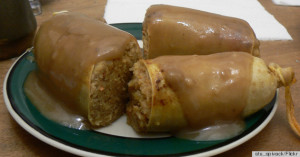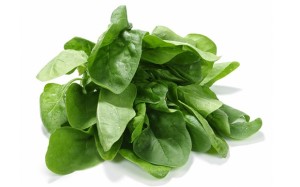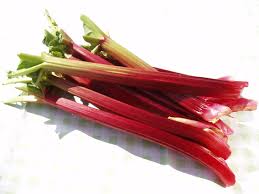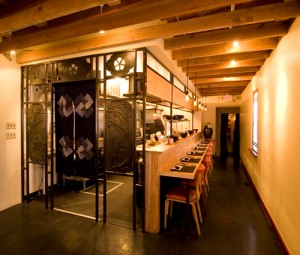HG is often nostalgic about the spicy, fatty, garlicky dishes HG’s Mom constructed during HG’s Bronx boyhood. A particular favorite was kishke (also known as “stuffed derma”). This was a beef intestine (or chicken neck) stuffed with matzo meal, chicken fat (obligatory in much of Mom’s cuisine); garlic, finely chopped onion and a plentiful amount of of salt, black pepper and paprika. This was roasted and served with long cooked brisket and gravy or pan broiled liver and onions. Good? Like Dashiel Hammet’s Maltese Falcon: “It was the stuff dreams were made of.” Kishke often appeared on the menus of the Jewish “Borscht Belt” hotels nestled in New York’s Catskill Mountains. The principal road leading to these resorts was nicknamed “the Derma Road.” “Kishkes” was a Yiddish slang term for stomach or guts. HG recalls fight fans at venues like St. Nicholas Arena and Sunnyside Garden cheering on headhunting Jewish boxers with the immortal phrase: “Hit him in the kishkes!!”
Kishke
September 15th, 2014 § 0 comments § permalink
Spinach – The Other Leafy, Green Treat
August 18th, 2014 § 0 comments § permalink
Kale seems to be the trendy, green, leafy vegetable of the moment but HG still prefers spinach. HG did not always love spinach. As a little fellow, HG expressed negative opinions regarding spinach. A believer in the nutritional value of the leafy, green wonder food, HG’s cunning Mom would enclose spinach in a mound of buttery, creamy mashed potatoes. She called the dish “buried treasure.” The romantic name — evoking pirates, the Spanish Main and wealth beyond imagination — convinced HG the vegetable was good stuff. These days HG associates spinach with many splendid restaurant dishes. Creamed spinach of sublime quality would accompany a thick cut of savory boiled tongue (plus a boiled potato and fiery English mustard) at Al Cooper’s Restaurant (long closed) in New York’s Garment Center. Creamed spinach was very good at Ben Benson’s Steak House (also closed) in midtown New York. Palm Restaurant (branches all over the country) serves whole leaf spinach sauteed in high-quality Italian olive oil and plenty of garlic with its steaks and hash browns. The Compound, in Santa Fe, flanks its Chicken Schnitzel in parsley caper sauce with some leaves of sautéed spinach. When HG lived in Colorado he lunched daily at 240 Union, the very good restaurant in Lakewood. The chef at the time, Matthew Franklin, would nest broiled or sautéed fish on a mound of spinach. There was always a plentiful amount of mashed potatoes. What made the dish sing was the abundance of melted butter. Cooking at home, HG likes to place a grilled paillard of chicken breast on some spinach cooked with oil, garlic and a tiny bit of nutmeg. A spinach risotto is a comforting dish as is a rice pilaf mixed with spinach. A very simple dish is some good tortelloni or ravioli plus spinach in steaming chicken broth. Popeye was right. Spinach makes muscle. Take that, Bluto!! Wham ! Bam ! Kazam !
Gefilte Fish
August 12th, 2014 § 0 comments § permalink
HG misses a champion quality warm weather dish: the Gefilte Fish prepared by HG’s late Mom. Often maligned due the rubbery, jellied, mass produced version served from a jar on Jewish holidays, Gefilte Fish means “stuffed fish.” But, this is misleading. The Gefilte Fish that we have come to know consists of chopped freshwater fish combined with matzo meal, eggs, grated onion and white pepper. This forcemeat is formed into balls, poached in strong fish broth and served cold with the jellied broth and strong horseradish — essentially a Jewish quenelle. Egg bread (challah) is the appropriate accompaniment. Little HG often acted as Mom’s sous chef in the preparation of Gefilte Fish. HG grated onion and horse radish and tried not to inhale the pungent fumes or scrape his knuckles on the box grater. Removed the fish heads and bones from the fish stock and dumped them in the garbage can. HG’s Mom chopped four varieties of fish — carp, pike, whitefish and buffel. This last fish, buffel, was a mystery to little HG. Years later HG learned this was a reference to Buffalo Fish. Buffel was the Yiddish translation (or Yinglish). These days Buffalo Fish can only be found at fishmongers in New York’s Chinatown. HG’s Mom used a high proportion of carp. This gave her fish balls a richer flavor and a much darker color than most other versions. Carp is native to China and was brought to Europe in the 17th Century by Jewish traders (and others) working the silk routes. Jews began cultivating carp in special ponds and it quickly became a significant holiday dish in Eastern European homes both Jewish and Gentile. Its popularity spread and “Carpe a la Juive” (jellied carp prepared in the Jewish style) rated four entries in France’s encyclopedic Larousse Gatronomique. HG’s Mom often prepared it. Not an HG favorite. HG preferred her rich and velvety Gefilte Fish — a humble and delicious dish with a sullied reputation.
Reviving a Depression Era Treat
August 2nd, 2013 § 0 comments § permalink
When HG was growing up in The Bronx during the Great Depression, nothing was ever wasted. All left over vegetables and their peelings, etc. went into an improvised soup that HG’s mom enriched with meat and chicken scraps and their flavorful bones. Left over fish was chopped with onions and celery (plus Hellman’s Mayonnaise) to become fish salad. Stale challah (egg bread) was used for very good French toast. Stale rye and pumpernickel (White bread of the Wonder and Silvercup variety had no place in Mom’s kitchen) got the roller pin treatment to make breadcrumbs (no food processors in those days). Fruit past its prime was mixed with dried prunes and cinnamon. Then stewed into an acceptable dessert fruit compote. Little HG looked forward to Mom’s treatment of left over boiled (or mashed) potatoes. They were mixed with fried onion and beaten eggs, formed into pancakes, fried to a crisp and devoured (happily) with sour cream and black pepper. Last night, BSK made smashed potatoes — boiled Prince Edward Island potatoes chopped roughly with scallions and hot chicken broth. On this rainy afternoon, HG found the left overs in the fridge. Mixed them with a beaten egg. Formed them into little patties and fried them in corn oil. Dusted them with sea salt and smoked pepper. Greek yogurt accompanied. HG was a kid again.
Rhubarb
July 21st, 2013 § 0 comments § permalink
Rhubarb (classified as a fruit by American agricultural agencies) grows easily in warm weather and is abundant on Prince Edward Island. In conversation, BSK noted that in the Ohio of BSK’s youth, rhubarb “always grew behind the garage.” Prince Edward Island neighbor Chuck P. presented HG/BSK with a big bunch. “Where did you get it?”, queried HG. Answer: “Behind my garage.” Okay. Mysteries of the world outside of New York continue to abound. BSK promised to cook it. HG took this news glumly. HG’s Mom would always cook up a big batch during the summer and did nothing to mitigate the fruit’s tartness. “Roobock (her pronunication) is good for you. Cleans you out.” Mom was referring to rhubarb’s properties as a laxative. Well, BSK cooked a batch of rhubarb with sugar and the first strawberries of the season. Delicious. HG is gobbling it up with fresh fruit and Greek yogurt. Needless to say, HG has the cleanest colon on PEI. Moral: Always listen to your Mother and always rely on BSK’s culinary skills.
Great Japanese Lunch At Shibumi Ramenya
April 4th, 2012 § 0 comments § permalink
Its true: Santa Fe doesn’t immediately pop up when thinking about Japanese food. While you do find a lot of New Mexico chili peppers, there’s also very good Japanese (and Italian) food available. HG’s favorite for sushi, sashimi and tempura is the very good Shohko Cafe. But, for delightful creativity and outstanding ramen and izakaya-style food, Shibumi Ramenya is the place. Here’s the lunch HG and Gifted AR, HG’s granddaughter, had recently. Started with a delightful burdock and carrot salad — slivers of burdock root and carrot sprinkled with sesame seeds and spiked with some fiery sesame oil. Healthy and delicious. Then, spicy pork gyoza, which, for some reason, reminded HG of the beef stuffed kreplach that HG’s Mom used to craft. Be assured, Shibumi’s very unkosher gyoza are better. Followed by big bowls of Tonkotsu ramen soup with springy noodles and melt-in-your-mouth slices of korubata pork. And, then the perfect dessert of strawberries and blackberries with custard and jam. Heaven. Will soon be back to sip superb sake and browse through the array of small plates utilizing the grill (yakitori) and the fryer (tempura). Must try the barbeque pork belly with eggplant; the cod and potato croquettes; the chicken yakitori and many other mouth watering plates. It’s all a tribute to chef/owner Eric Stapelman, a man totally dedicated to freshness and flavor. Before lunch, Eric gave HG and AR a tour of his back yard garden where he’s growing his own tomatoes, greens and herbs. From the garden to the plate with a touch of magic. That’s what Stapelman and Shibumi are all about.





